ALBERTA


ORIGIN OF PROVINCE NAME: Named after Princess Louise Caroline Alberta, fourth daughter of Queen Victoria.
NICKNAME: Princess Province, Energy Province, or Sunshine Province.
CAPITAL: Edmonton.
ENTERED CONFEDERATION: 1 September 1905.
MOTTO: Fortis et liber (Strong and free).
COAT OF ARMS: In the center, the provincial shield of arms displays the red Cross of St. George at the top on a white background (representing the province's bond with the United Kingdom), foothills and mountains in the center (symbolizing the Canadian Rockies), and a wheat field at the bottom (representing the province's chief agricultural crop). Above the shield is a crest with a beaver carrying a royal crown on its back. Supporting the shield are a lion to the left and pronghorn antelope to the right. Beneath the shield the provincial motto appears, with a grassy mount and wild roses.
FLAG: The flag bears the provincial shield of arms centered on a royal ultramarine blue background.
FLORAL EMBLEM: Wild rose (also known as prickly rose).
TARTAN: Alberta Tartan (green, gold, blue, pink, and black).
MAMMAL: Rocky Mountain bighorn sheep.
PROVINCIAL BIRD: Great horned owl.
TREE: Lodgepole pine.
STONE: Petrified wood.
TIME: 5 AM MST = noon GMT.
1 LOCATION AND SIZE
The westernmost of Canada's three prairie provinces, Alberta is bordered on the north by the Northwest Territories, on the east by Saskatchewan, on the south by the US state of Montana, and on the west by British Columbia. Alberta lies between the 49th and 60th parallels, at virtually the same latitude as the United Kingdom. Alberta is 756 miles (1,217 kilometers) from north to south and between 182 and 404 miles (293 and 650 kilometers) in width from west to east. Nearly equal in size to the state of Texas and covering an area of some 255,284 square miles (661,185 square kilometers), the province is Canada's fourth largest.
2 TOPOGRAPHY
Roughly half of the southwestern section of the province is dominated by mountains and foothills—striking reminders of the glaciers that, over millions of years, formed, moved, and receded in the area. Peaks of the Rocky Mountains located in Alberta range from 6,989 to 12,294 feet (2,130 to 3,747 meters) in elevation.
The foothills, which form a gentle link between mountain and prairie landscapes, feature heavily forested areas and grasslands used for grazing cattle. Beneath their surface, the foothills contain some of the province's richest deposits of coal and sour gas (natural gas containing hydrogen sulfide, which needs refining before being used in household furnaces and for other common uses).
The remainder of the province—approximately 90 percent of the land area—forms part of the interior plain of North America. The plains include the forested areas that dominate the northern part of the province and the vast stretches of northern muskeg (bog) that overlie much of Alberta's oil and gas deposits and oil sands (sand mixed with petroleum).
3 CLIMATE
Alberta has what is known as a continental climate. It is characterized by vivid seasonal contrasts in which long, cold winters are balanced by mild to hot summers. The climate also features an unusually high number of sunny days, no matter what the season. In fact, Alberta has more sunny days than any other province and is therefore sometimes called the "Sunshine Province." Although the whole province is covered in cold air in winter, in the southwest a mild wind, the "Chinook," frequently funnels through the mountains from the Pacific Ocean.
Alberta Population Profile
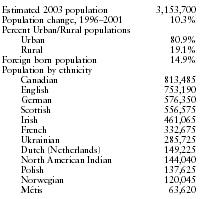
| Estimated 2003 population | 3,153,700 |
| Population change, 1996–2001 | 10.3% |
| Percent Urban/Rural populations | |
| Urban | 80.9% |
| Rural | 19.1% |
| Foreign born population | 14.9% |
| Population by ethnicity | |
| Canadian | 813,485 |
| English | 753,190 |
| German | 576,350 |
| Scottish | 556,575 |
| Irish | 461,065 |
| French | 332,675 |
| Ukrainian | 285,725 |
| Dutch (Netherlands) | 149,225 |
| North American Indian | 144,040 |
| Polish | 137,625 |
| Norwegian | 120,045 |
| Métis | 63,620 |
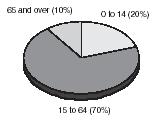
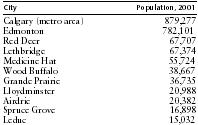
| City | Population, 2001 |
| Calgary (metro area) | 879,277 |
| Edmonton 782,101 | |
| Red Deer | 67,707 |
| Lethbridge | 67,374 |
| Medicine Hat | 55,724 |
| Wood Buffalo | 38,667 |
| Grande Prairie | 36,735 |
| Lloydminster | 20,988 |
| Airdrie | 20,382 |
| Spruce Grove | 16,898 |
| Leduc | 15,032 |
The average daily temperature for Calgary ranges from 15° F (-9° C ) in January to 62° F (17° C ) in July. Normal daily temperatures for Edmonton are 10° F (-12° C ) in January and 64° F (18° C ) in July. The
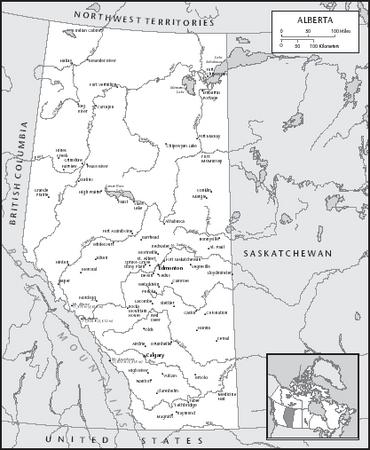
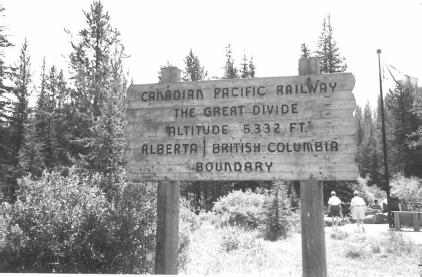
4 PLANTS AND ANIMALS
Alberta has 1,767 known species of vascular plants (ferns and all plants that reproduce through seeds), of which 87 are rare in Canada and 59 rare in North America.
Nonvascular species (such as mosses and lichens) number 1,180, of which about 30–50 percent are rare in North America. The slender mouse-ear-cress plant is threatened.
Alberta animal species include 90 mammals, 270 breeding birds, 50 fish, 18 reptiles and amphibians, and 20,000 insects. Endangered mammals include the swift fox, wood bison, and woodland caribou; endangered birds include the burrowing owl, barn owl, mountain plover, piping plover, and whooping crane. Threatened animals include the killer whale, Eastern sand darter, the loggerhead shrike, peregrine falcon, bull trout, and the northern leopard frog.
5 ENVIRONMENTAL PROTECTION
Since the 1950s, Alberta's development policy for using forests and other renewable resources has viewed land, water, vegetation, and wildlife management as one ecosystem (an ecological unit consisting of the organisms and the environment within a given area). The use of these resources is based strictly on keeping the ecosystem intact.
Air quality is generally good, and the incidence of smog is much less frequent in Edmonton and Calgary than in other large Canadian cities. The province has the highest rate of carbon dioxide emissions per capita (per person) in Canada. Alberta's solid waste to landfills declined by over 25 percent from the late 1980s to the late 1990s.
Water pollution is one of the more notable environmental concerns in Alberta. Water quality tends to be poorer downstream of urban, industrial, or agricultural development. In certain lakes and rivers mercury levels in some types of fish have forced Health and Welfare Canada to issue fish consumption advisories. Most of the mercury found in fish comes from natural sources in soils and sediment in Alberta. Additional problems, however, come from dioxins and furans, toxins that are generated from the burning of organic materials and also originate in wastewater discharges from industrial sites. In Alberta, paper mills are the most common source for dioxin and furan contamination of water resources.
In 1992/93, Alberta Environmental Protection was formed from the merger of the former departments of Forestry, Lands and Wildlife, and Environment, and the Parks Division of the former department of Tourism and Recreation. The agency is responsible for providing and maintaining clean air, water, and soil; protecting wild-life, forests, parks, and other natural resources; and making sure that the development of these resources is truly sustainable. On 1 September 1993 the Alberta Environmental Protection and Enhancement Act (AEPEA) went into effect, aiming to improve the province's environment through a variety of programs.
In 2001/02, stringent new emissions standards were established for all new coal-fired electricity generating plants and for expansions to existing plants. Regulations for beverage container recycling were expanded to include Alberta-based brewers. Consumers in Alberta now receive refunds on their beer bottles and cans, and those bottles and cans do not have to wind up in landfills. Offenders of environmental regulations paid nearly C $755,000 in fines and penalties in 2001/02.
6 POPULATION
As of 2001, Alberta had nearly 3 million inhabitants, or 10 percent of the national population. Approximately 80 percent of Albertans live in urban areas. More than half live in the two main cities—Edmonton, the province's capital (with a population of 782,101); and Calgary, (with a
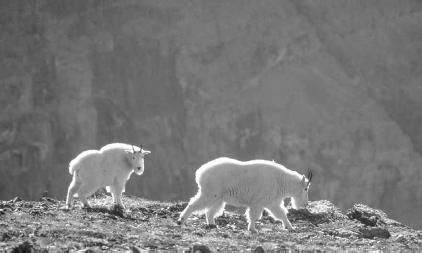
7 ETHNIC GROUPS
Roughly 47 percent of Albertans are of British descent. Other ethnic backgrounds with the largest number of people are German, Irish, French, Ukrainian, Dutch, Polish, and Norwegian. In 2001, Alberta had some 144,040 Native People (of Aboriginal descent) and 63,620 Métis (people of mixed European and Aboriginal descent). The largest Aboriginal groups are at Blood and Saddle Lake. Smaller ethnic groups, tracing their heritage to virtually every country in the world, make up the remaining 19 percent of the population. About eight percent of the population is neither Caucasian nor Aboriginal in origin.
8 LANGUAGES
English is the mother tongue of the majority of Albertans (80 percent in 2001) and is the primary language used in the province. French, Chinese, and German, however, are the dominant languages spoken in some communities.
9 RELIGIONS
Most Christian faiths are represented in Alberta. About 39 percent of the population, or about 1,145,460 people, are Protestant, the majority of whom are United Church of Canada members, with Anglicans, Lutherans, Baptists, Pentecostals, and Presbyterians represented. Alberta also has about 786,360 Catholics (the vast majority of whom are Roman Catholics, with a smaller number of Ukrainian Catholics), 44,475 people of Eastern Orthodox faith, 49,040 Muslims, 33,410 Buddhists, 23,470 Sikhs, 15,965 Hindus, and 11,085 Jews. Some 694,840 Albertans report no religious affiliation.
10 TRANSPORTATION
After the Canadian confederation was formed in 1867, the Canadian Pacific Railway was built, linking Alberta with the rest of Canada. Today, VIA Rail Canada provides transcontinental rail service with stops in Edmonton and Jasper.
The Trans-Canada Highway links Saskatchewan with Medicine Hat and Calgary before continuing on to Banff National Park and British Columbia. The Yellowhead Route of the Trans-Canada Highway connects Edmonton with Lloyd-minster and Saskatchewan in the east and with Jasper National Park and British Columbia in the west. Few highways exist in the northern half of the province. In 2003, Alberta had 2,333,194 registered road motor vehicles, 12,702 buses, 53,232 motorcycles and mopeds, and 763,675 trailers. In 2001, Alberta devoted C $92.4 million over the next five years for highway improvement projects.
Urban transit consists of buses, trolley coaches, and light-rail vehicles. Greyhound and Red Arrow provide bus service to most of the urban areas.
Edmonton and Calgary each have international airports served by such carriers as Air Canada, American Airlines, Canadian Airlines International, Delta, Horizon Air, KLM, Lufthansa, Northwest, Peace Air, United, and WestJet Airlines.
11 HISTORY
The province of Alberta, often called a Prairie Province because of its extensive grassland, is located in western Canada, just north of the US state of Montana. Early Albertans were probably ancestors of the ancient peoples who crossed the Bering Sea from Asia to the Americas thousands of years ago. The Blackfoot, Blood, Piegan, Cree, Gros Ventre, Sarcee, Kootenay, Beaver, and Slavey Indians, all speaking a variety of Athapaskan and Algonkian languages, were the sole inhabitants of what was then a vast wilderness territory. The woodland tribes of the central and northern regions in particular became valuable partners of the European fur traders who arrived on the scene in the 18th century.
The British Gain a Foothold in Alberta
Back in 1754, the first European explorer reached the territory that is now Alberta. His name was Anthony Henday. Nearly
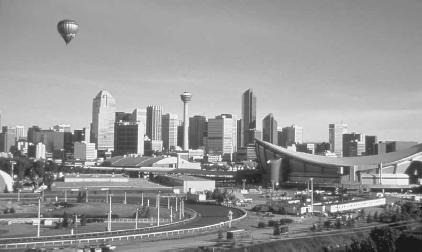
Expeditions led by Henry Youle Hind and John Palliser found that parts of the Alberta region—especially the fertile belt north of the Palliser Triangle—had exceptionally good land for farming. The Government of Canada purchased the Northwest Territories in 1870. After the passage of the Dominion Lands Act of 1872, farming families known as homesteaders began to acquire and cultivate land in the area. Eventually, the district of Alberta was established with Calgary as its capital.
The Population Grows
Beginning with the arrival of the railway in 1883, the population of the Alberta area started to grow quickly. Several other factors helped increase the population, among them the lack of new farmland in the United States and the discovery of new strains of wheat particularly suited to the climate of the Canadian Prairies. In 1897, when Canada's Minister of the Interior Clifford Sifton launched a huge advertising campaign offering good land for low prices, European settlers began to flow into the Western provinces from Germany, Romania, and the Ukraine. By 1901, Alberta's population had grown to 73,000. On September 1, 1905, Alberta—named for Princess Louise Caroline Alberta, fourth daughter of Britain's Queen Victoria—became a province of Canada, with Edmonton as its capital city. The province was created by joining the district of Alberta with parts of the districts of Athabasca, Assiniboia, and Saskatchewan.
Like the farmers in the other Prairie Provinces, Albertan farmers benefited from high prices for wheat during World War I (1914–1918). By the end of the war, though, global grain markets had collapsed, and wheat prices had fallen by 50 percent. Consequently, outraged farmers organized the United Farmers Movement in Alberta in 1921 to protest low farm product prices and high transportation rates.
Economic Ups and Downs
Over the course of the 1920s, grain prices recovered, and Canada as a whole experienced a period of rapid industrialization. Improvements to railways and roads boosted trade. Automobiles, telephones, electrical appliances, and other consumer goods became widely available. As in the United States, consumer confidence led to the rapid expansion of credit and greater business opportunities.
But the good times in Alberta ended with the onset of the Great Depression, a period of severe economic slowdown that began in 1929. In addition to the earlier problems with grain prices, droughts and frequent crop failures combined to devastate the economy of the province. Alberta became one of the most impoverished areas of Canada during the 1930s, and social welfare programs were rapidly expanded at this time to help the poor and the unemployed of the province.
Following World War II (1939–45), consumer spending and immigration to Canada increased rapidly. Urbanization, or the formation of cities, spread quickly with the passage of the National Housing Act, which made it easier for people to buy their own homes. Unemployment insurance and other social welfare programs were also created after the war.
The Discovery of Oil
Back in 1914, Ontario miner W. S. Heron had discovered oil in the Turner Valley, bringing the first wave of exploration companies to the province of Alberta. More than 30 years later, in 1947, a major oil discovery was made at Leduc. This had a huge impact on Alberta's economy. Up until this point, the economy had been tied mainly to agriculture, with support from coal and forest products. But as more and more oil and gas discoveries were made in the province, Alberta's prosperity became closely linked to these industries.
Oil exploration also uncovered another resource—natural gas. In the 1950s and 1960s, pipelines were built to carry natural gas to other provinces. People flowed into the province to take advantage of the numerous jobs available in the oil and gas industries, making cities and towns like Lethbridge, Red Deer, and Medicine Hat grow and prosper. As these industries boomed, however, farm population was cut in half.
Calgary, in particular, emerged as a major business and financial center in the 1960s and 1970s, with young professionals and laborers arriving from other parts of Canada and the United States in great numbers. When world oil prices rose in 1973, the average income in Alberta soared; between 1975 and 1983, total employment rose 41 percent. Because of its heavy reliance on the oil industry, however, Alberta's economy suffered a huge blow when oil prices fell in the 1980s. In response, the province made attempts to diversify, or expand, its economic horizons but encouraging growth in the forestry, technology, and tourism industries.
Branching Out
The international recognition granted to Alberta on the sports front in the 1980s did indeed boost tourism. The Edmonton Eskimos made history as the only Canadian Football League team to win the Grey Cup five seasons in a row, while the Edmonton Oilers brought home the National Hockey League's Stanley Cup five times in the same time period. The city of Edmonton also welcomed visitors from around the globe to such world class events as the Commonwealth Games in 1978 and the World Universiade Games in 1983. Five years later, in 1988, Calgary hosted the Winter Olympics. The Olympics were a welcome celebration that stood in stark contrast to the dark period experienced by the people of Alberta just one year earlier. In July of 1987 a tornado had ripped through Edmonton, killing 27, injuring hundreds more, and destroying more than 300 homes. In the end, the tornado caused more than $330 million in property damages. It remains one of the worst natural disasters in Canada's history.
On 17 December 1992, Canada joined the US and Mexico in signing the North American Free Trade Agreement (NAFTA), which was built upon the U.S.-Canada Free Trade Agreement. NAFTA, which was implemented in 1994, seeks to create a single market of 370 million people. At the same time, the number of telecommunication companies and businesses devoted to electronic design and manufacturing increased in Alberta. A whopping 90 percent of the province's information technology products are exported from the country.
In 1992, Ralph Klein of the Progressive Conservative party became premier of Alberta. Under his leadership, Alberta has become one of the most prosperous provinces in Canada, with a strong economy, a low unemployment rate, and the lowest personal income tax rate in the country.
Alberta's politics are more socially conservative than any other Canadian provinces. Alberta was also the center of the Canadian Alliance, once the second-largest political party in Parliament and the furthest right. In October 2003, the Canadian Alliance merged with the Progressive Conservative Party to form the new Conservative Party of Canada.
12 PROVINCIAL GOVERNMENT
The structure of the provincial government reflects that of the federal government. For example, the provincial premier, as the majority party leader of the legislature, functions much like the Canadian prime minister. Provincial legislators, like their federal counterparts in Parliament, are elected to represent a constitutional jurisdiction and pass legislation. They do so as members of the 83-seat Legislative Assembly. A provincial lieutenant-governor approves laws passed by the legislature, much like the Governor General at the federal level. There is no provincial equivalent, however, to the federal Senate.
13 POLITICAL PARTIES
Political affiliation was not important in Alberta until the 1910s, when differences between the Liberal Party and the Conservative Party became more prominent. A growing nonpartisan (not connected with a party) movement in the late 1910s saw the rise of the United Farmers of Alberta (UFA); the UFA held the majority from 1921 to 1935. The Social Credit Party (Socred), based on the belief that the government should control credit, held the vast majority of legislative seats from the mid-1930s to the early 1970s. During their period in power, the welfare state was expanded.
On 12 March 2001, a general election was held. The parties held the following number of seats in Alberta's Legislative Assembly in 2001: Conservatives, 74; Liberals, 7; and New Democrats, 2.
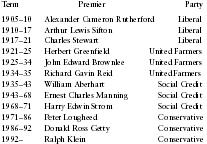
| Term | Premier | Party |
| 1905–10 | Alexander Cameron Rutherford | Liberal |
| 1910–17 | Arthur Lewis Sifton | Liberal |
| 1917–21 | Charles Stewart | Liberal |
| 1921–25 | Herbert Greenfield | United Farmers |
| 1925–34 | John Edward Brownlee | United Farmers |
| 1934–35 | Richard Gavin Reid | United Farmers |
| 1935–43 | William Aberhart | Social Credit |
| 1943–68 | Ernest Charles Manning | Social Credit |
| 1968–71 | Harry Edwin Strom | Social Credit |
| 1971–86 | Peter Lougheed | Conservative |
| 1986–92 | Donald Ross Getty | Conservative |
| 1992– | Ralph Klein | Conservative |
14 LOCAL GOVERNMENT
Albertan municipal government consists of rural and urban municipal governments. Rural municipal governments (counties and municipal districts whose elected councils are responsible for all services) are large land areas with relatively few people. In these areas, the provincial government provides all services and collects the taxes. Urban municipalities are autonomous (self-governing) political units. These include summer villages (resort areas), villages, towns, new towns (with special borrowing privileges), and cities. In order for an area to be incorporated, a summer village must contain 50 separate buildings that are occupied annually for six months, a village must have 75 such residences occupied annually for six months, a town needs 1,000 inhabitants, and a city must have a population of at least 10,000.
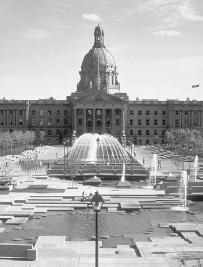
15 JUDICIAL SYSTEM
The Canadian Constitution grants provincial jurisdiction over the administration of justice, and allows each province to organize its own court system and police forces. The federal government has exclusive domain over cases involving trade and commerce, banking, bankruptcy, and criminal law. The Federal Court of Canada has both trial and appellate (having the power to review the judgment of another court) divisions for federal cases. The nine-judge Supreme Court of Canada is an appellate court that determines the constitutionality of both federal and provincial statutes. The Tax Court of Canada hears appeals of taxpayers against assessments by Revenue Canada.
The Provincial Court in Alberta has a total of five primary divisions (civil, criminal, traffic, family, and youth courts). The Queen's Bench is the superior trial court for the province, hearing trials in civil and criminal matters and appeals from decisions of the Provincial Court. There is one intermediate Court of Appeal.
In 2002, there were 70 murders in Alberta. There were 1,077 violent crime offenses per 100,000 persons in 2002, and 4,663 property crimes per 100,000 persons.
16 MIGRATION
Tracing the roots of Alberta's nearly 3 million people begins with the province's Native, or Aboriginal, Peoples and leads to virtually every corner of the globe. During the last ice age, portions of Alberta served as an ice-free corridor through which Aboriginal Peoples made the trek from Asia. The province's native people formed the bulk of the area's population until the 1880s, when they were outnumbered by growing populations of Europeans. In 1881, there were barely more than 1,000 non-native people in the area that was to become the province of Alberta. Ten years later, 17,500 non-native people occupied the territory.
Between the 1890s and the 1920s, immigrants from many countries came in response to the Canadian government's aggressive efforts to promote immigration and encourage agricultural development. After World War I, most of the immigrants came from Europe or the United States. By the end of the immigration push in 1921, there were 584,454 Albertans. After World War II, the pattern changed. Beginning in the 1960s, immigrants came from all over the world, including the Pacific Rim, Asia, and the Caribbean.
In 2001, 13.7 percent of all immigrants living in Alberta had come from the United Kingdom, 6.3 percent from the United States, 13.3 percent from Southeast Asia, 12.8 percent from East Asia (including China), and 12.5 percent from Northern and Western European countries other than the United Kingdom.
In 2001, 2.9 percent of Alberta's residents age 5 and older were living abroad. Some 11.1 percent were living elsewhere in Alberta, while 8.8 percent were living in another province. Most interprovincial migration was with British Columbia.
17 ECONOMY
Alberta's economy is based on agriculture, energy, and other resource-based industries. Since the 1970s, Alberta has experienced rapid economic growth in such industries as petrochemicals, forest products, electronics, and communications. Other growth areas are tourism and business services, including computer software, engineering, and scientific and technical services.
In 2002, Alberta's gross domestic product totaled C $149.9 billion, or about 12.9 percent of the national total.
18 INCOME
Average family income in the province was C $73,494 for a family of five as of 2000. As of 2000, average weekly earnings in Alberta amounted to C $626.45.
19 INDUSTRY
Food and beverage processing remains the largest manufacturing industry in Alberta in terms of both sales and employment. Petrochemicals and plastics, forest products, metals and machinery, and refineries have all become increasingly important parts of Alberta's economy. Chemical companies in Alberta such as Dow Chemical Canada, Nova Chemicals, and Shell Chemicals Canada produce specialty chemicals. (The Union Carbide Corporation—previously operating in Alberta—and the Dow Chemical Company merged in 2001, and Union Carbide became a wholly owned subsidiary of Dow Chemical.) A wider variety of industrial products—including aerospace and transportation equipment, and industrial and specialty chemicals—is also being manufactured in Alberta.
Alberta's manufacturing shipments were valued at C $40.9 billion in 2002. The largest contributors were: food and beverages, C $9.8 billion; refined petroleum, C $7.5; chemical products, C $6.5 billion; forest products (includes wood and pulp and paper industries), C $3.8 billion; machinery, C $2.9 billion; fabricated metals, C $2.7 billion; construction materials, C $1.5 billion; electrical and electronic products (including telecommunications equipment), C $1.4 billion; plastics, C $1.0 billion; primary metals, C $0.9 billion; furniture
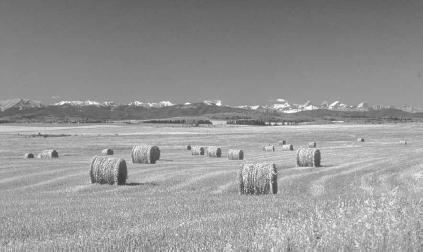
20 LABOR
In 2003, Alberta had a labor force of 1.83 million. As of that year, about 1.74 million persons were employed, with about 84,400 unemployed. The overall unemployment rate was 4.6 percent, the lowest rate among the provinces in 2003. The hourly minimum wage in Alberta as of January 2004 was C $5.90, which was the lowest hourly minimum wage rate among the provinces.
In 2003, the sectors with the largest numbers of employed persons were: trade, 277,200; health and social services, 156,400; manufacturing, 152,200; construction, 145,400; accommodation and food services, 124,000; professional, scientific, and technical services, 122,900; forestry, fishing, mining, and oil and gas, 109,100; educational services, 108,300; finance, insurance, real estate and leasing, 93,900; transportation and warehousing, 92,500; other services, 77,400; public administration, 75,300; information, culture, and recreation, 70,800; agriculture, 65,200; management, administrative, and other support, 57,200; and utilities, 13,100.
21 AGRICULTURE
Alberta has one of the world's most productive agricultural economies, producing about 26 percent of the value of Canada's annual output. Some 9.7 million hectares (23.9 million acres) of land are under cultivation. While wheat remains the primary crop, the production of new crops continues to expand. Of Canada's total crop production, Alberta typically produces about 25 percent of the wheat, 40 percent of the canola, 45 percent of the oats, and 50 percent of the barley.
About 72 percent of Alberta's agricultural products are made up of field crops. Fruits, vegetables, or greenhouse products make up 10.7 percent of all products produced. The area devoted to greenhouse production under glass, plastic, or other protection increased 36.2 percent from 1996 to 2001. The top two fruit crops produced in Alberta are saskatoons (a berry) and strawberries. The top two field vegetable crops are green peas and sweet corn.
According to the 2001 federal census, Alberta had 53,652 farms (second after Ontario) on 21 million hectares (52 million acres), about half of which is used for crops. The average farm covered 393 hectares (971 acres). Living on a ranch or farm is a valued way of life. Many farmers must supplement their earnings with off-farm income. Average gross receipts for a farm operator (excluding forest products sold) were C $183,693 in 2000, but average expenses of operating were C $164,973 that year, leaving C $18,720 before interest payments and taxes. Total farm cash receipts in Alberta were C $9.92 billion in 2000 (excluding forest products sold).
22 DOMESTICATED ANIMALS
Cattle and their keepers arrived in Alberta in the 1870s, about 20 years before the farmers. Eventually the ranchers and farmers learned to live together in peace; farmers cultivated land in southeastern and central Alberta, while livestock production predominated in the western foothills of the Canadian Rocky Mountains.
Approximately 22 million hectares (54 million acres) of cultivated and uncultivated land are used as pasture and forage for livestock. Alberta maintains the largest livestock population in Canada. Livestock receipts for 2003 were C $5.09 billion. Beef cattle production is Alberta's largest agricultural sector, providing over 50 percent of farm production income. Beef cattle production in Alberta contributes C $3.8 billion in farm income each year. The livestock population as of 1 January 2004 included 5.68 million head of cattle, 2.05 million pigs, and 175,000 sheep.
On 20 May 2003, it was disclosed that a cow in Alberta had bovine spongiform encephalopathy, or "mad cow disease." The US and other Canadian beef importers placed an immediate ban on exports of Canadian beef, which lasted until September 2003. Canada is the world's third largest beef exporter, and Alberta accounts for 60 percent of Canada's beef production. Herd sizes in all Canadian provinces rose after the ban ended. By January 2004, herd sizes in Alberta had risen by 6.9 percent.
Alberta also has more horses than anywhere else in Canada. Commercial apiculture (beekeeping) is also popular.
23 FISHING
Sport fishing in Alberta's numerous lakes and streams is an important part of the tourism industry. Prominent species sought include brown trout, eastern brook trout, northern pike, rainbow trout, walleye, and yellow perch.
As of 2000, Alberta had 182,044 residents actively engaged in sport fishing. Alberta is divided into eight fish management districts; each is responsible for the maintenance of local stocks. The Fish Culture Branch of the Alberta Fish and Wild-life Service annually stocks lakes and streams with trout, walleye fry, and walleye fingerlings.
24 FORESTRY
About 58 percent of the total land area of Alberta, or approximately 94.4 million acres (38.2 million hectares), is covered by forests. About 61 percent of the total forest area is classified as commercially productive forest land and contains both hardwood and softwood species. In 2000, the timber harvest totaled 21.9 million cubic meters, well under the annual allowable cut of 27.4 million cubic meters. Wood pulp, softwood lumber, and wafer-board are the most important forestry products in terms of value of shipments. Becoming more important, however, are higher value-added products such as news-print, panelboard products, particle-board, laminated veneer and beams, cabinetry, and home and office furniture. The total value of exports was C $2.8 billion in 2002. There were some 20,000 persons employed in the forest industry in 2002.
25 MINING
Besides oil, natural gas, and coal, Alberta mines small quantities of sulfur, sand, cement, gravel, limestone, salt, and gold.
In 2003, Alberta produced 50 kilograms (110 pounds) of gold.
The value of production in 2003 for industrial minerals was C $837.6 million; and for metals, C $813,000 (all from gold).
26 ENERGY AND POWER
In 1947, an enormous oil field was discovered at Leduc, near Edmonton. Oil transformed the province's modest agricultural economy into one of the most prosperous in Canada. By 1956, Alberta's oil production met 75 percent of Canada's demand. In 2002, Alberta provided 71 percent of the total value of Canadian fuel production. Alberta has more than 50 percent of the country's reserves of conventional crude oil, over 80 percent of its natural gas, and 45 percent of its coal reserves. The first natural gas well was drilled in 1901 at a field near Medicine Hat. The oil and natural gas sector responded to the challenges of unstable energy prices in the 1980s by significantly reducing production and operating costs.
In 2002, Alberta's mineral fuel production was C $43.8 billion, an increase of more than 60 percent from 1997. In 2002, energy resource exports accounted for C $30.5 billion of Alberta's exports. This was about 56 percent of Alberta's total exports of goods and services. Much of Alberta's oil is exported to the United States.
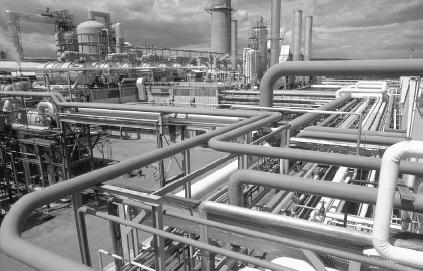
Alberta is the largest coal producer in Canada. In 2002, Alberta produced 31 million tons (46 percent of Canada's total coal production), for a total value of C $387 million.
Alberta's refineries, which serve most of western Canada, constitute about 20 percent of Canada's total refining capacity. Five refineries have a combined capacity of just under 375,000 barrels per day. Transportation fuels (including gasoline, diesel fuel, and aviation fuel) make up 80 percent of all production. Other products include heating oil, asphalt, petrochemical feedstock, kerosene, ethylene derivative products, and lubricants. The Interprovincial Pipe Line (IPL), which originates in Edmonton and passes through Saskatchewan, transports crude oil from both Alberta and Saskatchewan to markets in eastern Canada and the United States.
Alberta's installed generating capacity of electricity was 12,400 megawatts in 2003. Peak demand was 8,433 megawatts. Plans for 5,200 megawatts of new additional generation worth more than C $5 billion were announced as of 2003. Electricity exports in 2003 were 923,492 megawatt hours, valued at C $40.7 million. Imports were 979,377 megawatt hours, valued at C $95.3 million.
27 COMMERCE
In 2002, Alberta exported a total of C $49.3 billion and imported C $12.8 billion in merchandise. In 2002, 88 percent of exports went to the United States, and 72.5 percent of imports were from the United States.
The service sector accounts for more than 60 percent of Alberta's economic output. More than two-thirds of Alberta's employment is found in such industries as business and financial services, transportation, retail trade, health and education services, and tourism.
28 PUBLIC FINANCE
The fiscal year runs from 1 April to 31 March. For fiscal year 2002/03, total revenues were forecast at C $22.57 billion; expenditures were C $20.76 billion. Major expenditure areas were health, education, social services, agriculture and economic development, interest on debt, regional planning and development, and protection of persons and property. In the 2002/03 fiscal year, provincial debt amounted to C $4.8 billion.
29 TAXATION
Alberta is the only province that has no provincial retail sales tax, and it has the lowest gasoline tax ( C $.09/liter) in Canada. The cigarette tax is C $32 per carton (as of March 2002).
The basic personal income tax rate was 44.3 percent in 2003. The average family of four (two parents and two children) earned C $95,349 in 2003, and paid C $40,219 in taxes.
Effective as of April 2003, the provincial general corporate income tax rate was 12.5 percent, and 4 percent for small businesses, among the lowest in Canada. There were no capital taxes in 2003.
30 HEALTH
In 2001 there were 37,619 live births in Alberta, an increase of 1.7 percent over 2000. There were 17,579 deaths occurring that year, a 1.8 percent increase over 2000. Alberta was one of only four provinces or territories to have an increase in the number of live births in 2001. It was also one of four provinces or territories to have an increase in the number of deaths in 2001. Average life expectancy for men was 77 years, and 82.4 years for women. Reported cases of selected diseases in 2002 included chicken pox, 2,156; giardiasis, 440; gonococcal infections, 980; campylobacteriosis, 1,396; and salmonellosis, 842. There were an estimated 10,800 new cases of cancer in 2001. Between November 1985 and June 2003, 3,868 residents had become infected with HIV, the virus that causes AIDS.
31 HOUSING
Alberta had 1.1 million households in 2001. The average number of persons living in a household was 2.6. In 2001, 64.9 percent of Alberta's households lived in single detached houses, 13.7 percent lived in apartments in buildings with fewer than 5 stories, 7.1 percent lived in row houses, 4.5 percent lived in apartments in buildings with 5 or more stories, 4.3 percent lived in semi-detached dwellings, and 3.3 percent lived in mobile homes.
Alberta is the third most affordable housing market in Canada. The average price of a house in Edmonton in 2002 was C $150,165, and in Calgary, it was C $198,350. The average price of a house in these cities was 30–50 percent less than a home in Toronto or Vancouver.
32 EDUCATION
The first schools in Alberta were founded by Catholic and Protestant missionaries in the mid-1800s. When Alberta entered the Canadian confederation in 1905, there was one provincial education system which allowed separate schools for the dissenting religious minority. The 1930s saw the introduction of social studies, junior high schools, rural school administration, adult education, and increased benefits for teachers.
Public education in Alberta is a shared responsibility of the provincial government and local school boards. In areas such as curriculum and teacher certification, Alberta Education (the provincial education department) has overall authority. Local school boards employ teachers and operate schools at the elementary (grades 1–6), junior high (grades 7–9), and high school (grades 10–12) levels.
In 2000/01, Alberta had 78,135 students enrolled in grades 1–12. From 1996 to 2001, school enrollment grew faster in Alberta (5.4%) than anywhere else in Canada. There are 17 students per teacher in the province. There are also over 190 private schools (primarily religious or language-based); these schools receive about 70 percent of the provincial funding provided to public schools.
In 1995, Alberta became the first province to approve charter schools, allowing parents and local communities to set up specialty schools or programs independent of the support of local school boards. The first four charter schools opened in Edmonton and Calgary.
There are seven universities in Alberta. The University of Alberta in Edmonton, with 34,000 students as of 2004, is Canada's second-largest English-language university. The average undergraduate tuition at the University of Alberta or University of Calgary for the 2003/04 year was C $2,400.
33 ARTS
Cultural activities in Edmonton include the Edmonton Symphony Orchestra, the Alberta Ballet, the Edmonton Opera Company, and more professional live theater companies per person than any other city in Canada. Every year, Edmonton hosts an international jazz festival and a large alternative theater celebration. Calgary's Centre for the Performing Arts is the permanent home of the Calgary Philharmonic Orchestra and has three theaters.
Local arts and culture organizations held almost 8,600 events in 2002. Some 10.6 million people attended more than 21,000 shows at those events. Also, 36 major festivals entertained 2.3 million people.
34 LIBRARIES AND MUSEUMS
The largest public libraries in the province are the Calgary Public Library and the Edmonton Public Library, each with nearly 20 branches. Alberta's history is the focus of many museums and historical sites, including the Royal Tyrrell Museum of Paleontology in Drumheller, Frank's Slide in Crowsnest Pass, Head-Smashed-In Buffalo Jump in Grande Prairie, the Reynolds-Alberta Museum in Wetaskiwin, and the Remington-Alberta Carriage Centre in Cardston. The Provincial Museum of Alberta in Edmonton chronicles the natural and human history of the province.
35 COMMUNICATIONS
In 2004, Calgary had 6 AM, 17 FM, and one Internet radio stations, and 6 television stations. Edmonton had 10 AM and 13 FM radio stations and 6 television stations.
For the fifth year in a row, in 2001 Alberta led the nation in online use with 65 percent of Alberta households accessing the Internet.
36 PRESS
Daily newspapers in the two largest metropolitan areas are the Calgary Herald and The Calgary Sun , and the Edmonton Journal and The Edmonton Sun . Other daily newspapers are published in Fort McMurray, Grande Prairie, Lethbridge, Medicine Hat, and Red Deer. Windspeaker is a monthly national Aboriginal newspaper.
37 TOURISM, TRAVEL, AND RECREATION
The province offers a multitude of attractions to visitors, and prides itself on the magnificent Rocky Mountains, especially the celebrated Jasper and Banff National Parks. As of 1998, Alberta had 26,199 square miles (67,855 square kilometers) designated as parks and natural reserves. Over 4.6 million people visited Banff National Park in 2003, and over 1.8 million people visited Jasper National Park. Other parks include Elk Island, Waterton Lakes, and Wood Buffalo national parks.
In 2002, receipts from tourism amounted to C $5.45 billion; 53 percent came from fellow Albertans, 22 percent from out-of-province visitors, and 25 percent from foreign visitors. Many of Alberta's foreign tourists come from the United Kingdom, Japan, Germany, and Australia.
The West Edmonton Mall is the world's largest combined shopping/entertainment center.
38 SPORTS
Rodeos, many of which are part of the North American Rodeo Circuit, are popular sporting events during the summer months throughout Alberta. The Calgary Stampede, held annually during the first ten days of July, is the largest rodeo in the world.
Alberta has two National Hockey League (NHL) teams: the Calgary Flames and the Edmonton Oilers, both in the Pacific Division of the Western Conference. The Flames won the Stanley Cup in
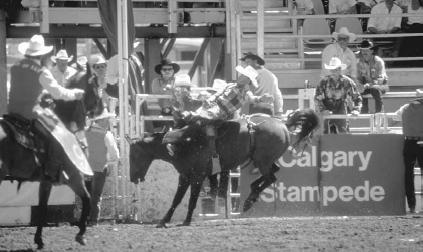
The Calgary Stampeders and Edmonton Eskimos play in the Canadian Football League (CFL); the Stampeders won the Grey Cup (Canadian Football League championship) four times (1971, 1992, 1998, 2001). The Eskimos took the CFL championship in 1954–56, 1975, 1978–82, 1987, 1993, and 2003.
The Triple A level team for Major League Baseball's Florida Marlins is the Edmonton Trappers. The Edmonton Drillers play indoor soccer in the National Professional Soccer League.
Two women's hockey teams, the Calgary X-Treme and Edmonton Chimos, play in the National Women's Hockey League (NWHL). Calgary gained international attention as the host of the Olympic Winter Games in 1988.
39 FAMOUS ALBERTANS
Progressive Conservative Charles Joseph "Joe" Clark (b.1939), originally from High River, served as Canada's prime minister from June 1979 to March 1980.
Famous Albertans in entertainment include actors Fay Wray (b.1907), Conrad Bain (b.1923), and Michael J. Fox (b.1961). Joni Mitchell (b.1943) and k. d. lang (b.1961) are prominent Albertan singers.
Notable literary persons include poet and novelist Earle Birney (1904–95), communications theorist Marshall McLuhan (1911–80), novelist Robert Kroetsch (b.1927), novelist and short story writer W. P. Kinsella (b.1935), and novelist Katherine Govier (b.1948).
Hockey star Lanny McDonald (b.1953) is a native of Hanna, while three-time World Figure Skating champion Kurt Browning (b.1966) was born in Caroline.
40 BIBLIOGRAPHY
Laws, Gordon D. Alberta. San Diego: Lucent Books, 2003.
LeVert, Suzanne. Dominion of Canada . Philadelphia: Chelsea House, 2000.
Sorensen, Lynda. Canada: Provinces and Territories . Vero Beach, Fla.: Rourke Book Co., 1995.
Yates, Sarah. Alberta . Minneapolis: Lerner Publications, 1996.
Web sites
Alberta Economic Development. http://www.edt.gov.ab.ca (accessed on March 19, 2004).
Canada Tourism. http://www.canadatourism.com/ctx/app (accessed on March 19, 2004).
"Discover Alberta." Alberta Travel and Tourism. http://www.discoveralberta.com (accessed on March 19, 2004).
Government of Alberta. http://www.gov.ab.ca/home/index.cfm (accessed on March 19, 2004).
Statistics Canada. http://www.statcan.ca/english (accessed on March 19, 2004).
* KILLER WHALE IN ALBERTA??
Thnks!!!:)